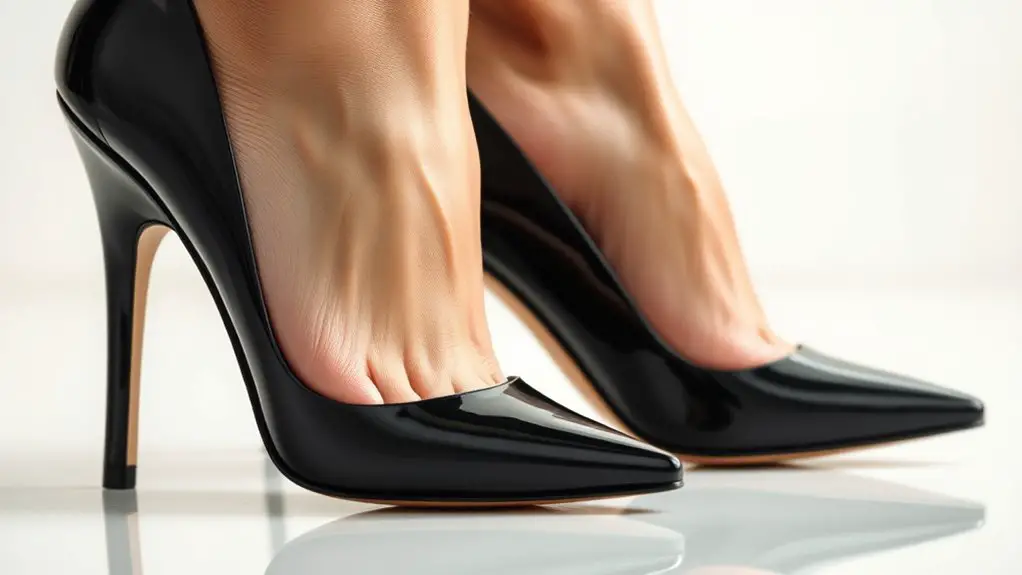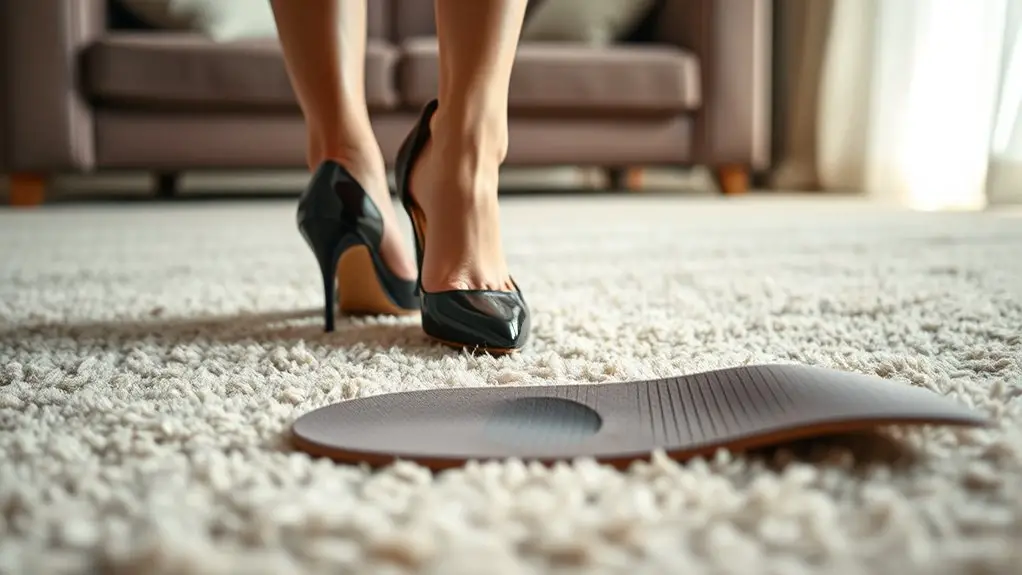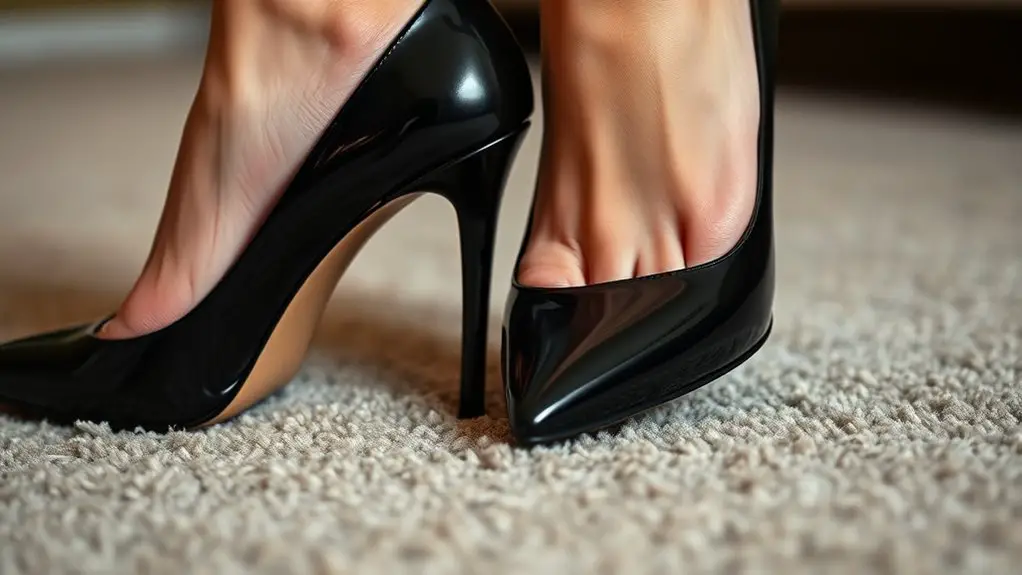High heels affect blood circulation in your feet by altering alignment, which compresses blood vessels and restricts blood flow. The elevated position shifts your weight forward, increasing pressure on the forefoot and impairing venous return. This can lead to discomfort, swelling, and potential vascular issues. Inadequate arch support exacerbates these problems, straining foot structures. To better understand how to maintain foot health while wearing heels, you might consider exploring effective strategies and alternatives.
Understanding Blood Circulation in the Feet

While you might not think about it often, understanding blood circulation in your feet is important for overall health. Blood flow in your feet relies on a complex system of arteries and veins. Arterial blockage can hinder the delivery of oxygen-rich blood, leading to pain and potential tissue damage. The arteries supply blood from the heart, while the veins are responsible for venous return, transporting deoxygenated blood back.
Inadequate venous return can result in swelling and discomfort, particularly in individuals who stand for long periods or wear restrictive footwear. The role of calf muscles is significant; they act as a pump, facilitating blood flow during movement. When blood circulation is compromised, it can lead to serious conditions, including varicose veins or deep vein thrombosis. Being mindful of how your footwear affects this circulation is important for maintaining foot health and overall well-being.
The Anatomy of High Heels and Their Design
High heels are a distinctive type of footwear characterized by their elevated heels, which can vary considerably in height and style. The heel elevation is a primary feature that alters the foot’s natural position, shifting weight forward and affecting overall posture. Typically, high heels lack adequate arch support, which can lead to an increased strain on the foot’s structures, including ligaments and muscles. This design often emphasizes aesthetics over functionality, resulting in a narrow toe box and a rigid sole, further complicating comfort and stability. The angle created by the heel elevation can also contribute to altered biomechanics, impacting how forces are distributed across the foot. Understanding the anatomy of high heels, including their lack of arch support and pronounced heel elevation, is essential for recognizing the potential implications on foot health and comfort. By being aware of these design elements, you can make more informed choices about footwear.
The Impact of High Heels on Blood Flow

The design characteristics of high heels considerably influence blood circulation in the feet and lower legs. High heel biomechanics alter your foot’s natural alignment, resulting in uneven pressure distribution across the sole. This pressure can compress blood vessels, restricting blood flow and leading to potential circulatory issues. As you shift your weight forward onto the forefoot, the heel elevation exacerbates this compression, affecting venous return and promoting stagnation in the lower extremities.
Reduced circulation may cause discomfort, swelling, and an increased risk of developing vascular problems over time. The elevated position of the heels also forces the calf muscles to contract more, which can further impede blood flow. Consequently, understanding how high heels impact blood flow is essential for making informed choices about footwear to maintain healthy circulation. Ultimately, mindful selection of heel height and fit can help mitigate these adverse effects.
Common Foot Health Issues Linked to High Heels
As you navigate daily activities in high heels, you may unknowingly expose your feet to various health issues. The elevated position and narrow design of high heels can lead to several common foot problems, including:
- Bunions Formation: The pressure from high heels can cause misalignment of the big toe, leading to painful bunions.
- Plantar Fasciitis: The lack of arch support in high heels can strain the plantar fascia, resulting in inflammation and heel pain.
- Metatarsalgia: High heels can increase pressure on the ball of the foot, causing pain and discomfort.
- Achilles Tendonitis: Wearing heels may shorten the Achilles tendon over time, leading to stiffness and pain.
Being aware of these issues helps you make informed choices about your footwear, potentially reducing the risk of long-term foot complications. Prioritize comfort and support to maintain your foot health.
Strategies for Reducing Circulatory Risks

While you may enjoy the elegance of high heels, implementing strategies to mitigate circulatory risks is essential for maintaining foot health. One effective method is wearing compression socks, which can enhance blood flow and reduce swelling. These specialized socks apply gentle pressure to your legs, promoting circulation and preventing discomfort associated with prolonged heel use.
Additionally, incorporating foot exercises into your routine can greatly counteract circulatory issues. Simple stretches, such as toe raises or ankle rotations, can help alleviate tension and stimulate blood flow. It’s also beneficial to take regular breaks while wearing heels, allowing your feet to rest and recover.
Choosing Fashionable Alternatives for Foot Health
When seeking stylish options that prioritize foot health, consider footwear designed with both aesthetics and comfort in mind. Here are some fashionable alternatives to high heels that help maintain proper blood circulation:
- Fashionable flats: Look for pairs with cushioned insoles and arch support to reduce pressure on your feet.
- Supportive sneakers: Choose sneakers that offer breathability and shock absorption, allowing for all-day comfort.
- Ankle boots with low heels: Opt for designs that provide stability while still being trendy, ensuring your feet stay well-supported.
- Loafers or slip-ons: These can be both chic and functional, offering easy wear without compromising on foot health.
Frequently Asked Questions
Can High Heels Cause Permanent Damage to Foot Circulation?
Yes, wearing high heels can lead to permanent effects on your foot circulation. Prolonged use may cause circulation issues, resulting in discomfort, varicose veins, and other complications that could impact your overall foot health.
Are Certain Heel Heights More Damaging Than Others?
Studies show that 60% of women experience foot discomfort from wearing high heels. Higher heel heights tend to exacerbate this discomfort, leading to increased pressure on the feet, considerably affecting overall foot comfort and circulation.
Do High Heels Affect Blood Circulation Differently for Men and Women?
High heels can indeed affect circulation differently for men and women. Gender differences in anatomy and biomechanics lead to varied circulation effects, with women often experiencing greater compression and restricted blood flow due to heel height and foot structure.
How Often Should I Take Breaks From Wearing High Heels?
You should take breaks every hour when wearing high heels to improve comfort and circulation. Consider heel rotation with different styles to minimize strain, ensuring your feet remain healthy and reducing potential long-term issues.
What Are the Signs of Poor Circulation Caused by High Heels?
You might notice foot pain, numbness, or swelling if you’re experiencing circulation issues. These signs often indicate that high heels are compromising blood flow, emphasizing the importance of monitoring your foot health during prolonged wear.



